Introduction
Silicone plates for babies have become increasingly popular due to their numerous benefits. This article will provide a comprehensive guide to help you choose the best silicone plate for your little one while discussing essential features and factors to consider.
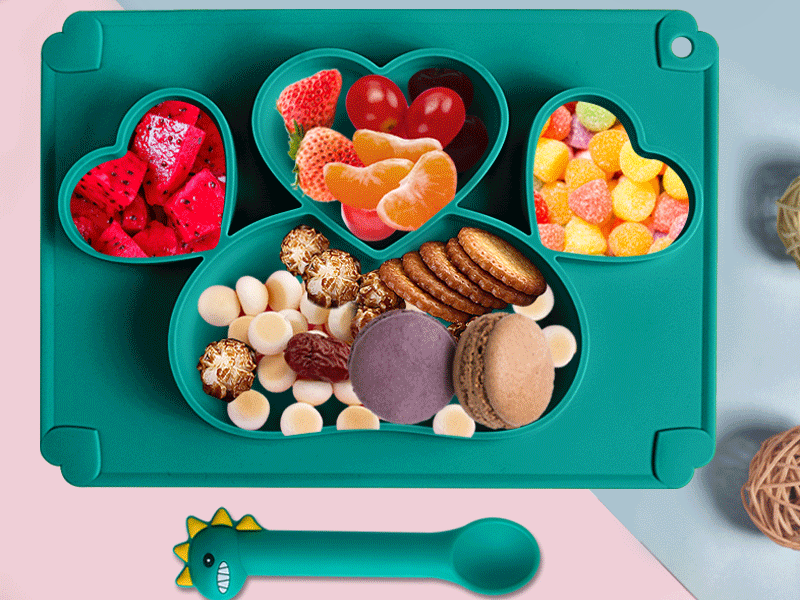
1. Material Quality
The material quality of a silicone plate is a vital aspect to consider when choosing the best product for your baby. It is important to select a plate made from high-quality food-grade silicone for various reasons:
- High-quality silicone is more durable and resistant to wear and tear, ensuring that the plate lasts longer and maintains its appearance and functionality.
- Food-grade silicone is free from toxins and contaminants, making it safe for your baby to eat. This is particularly important because babies have delicate immune systems and are more susceptible to the adverse effects of harmful substances.
- A high-quality plate is less likely to retain odors and stains, ensuring that the plate remains hygienic and visually appealing.
However, it is also essential to be aware of the potential dangers associated with certain chemicals commonly found in plastic products. BPA (bisphenol A), phthalates, and other harmful chemicals can leach into food and have been linked to various health issues. Look for silicone plates that are BPA-free and comply with safety regulations.
To ensure the silicone plate you choose is safe for your baby, consider the following tips:
- Purchase from reputable brands known for their commitment to safety and quality.
- Check for safety certifications and compliance with international standards, such as the FDA (U.S. Food and Drug Administration) or LFGB (German Food and Feed Code).
- Read customer reviews and testimonials to gain insight into the experiences of other parents who have used the product.
- Look for clear labeling on the product packaging that indicates it is BPA-free, phthalate-free, and made from food-grade silicone.
- If you have concerns about the safety of a specific plate, consult a pediatrician or other healthcare professional for guidance.
By prioritizing material quality, you can ensure that the silicone plate you choose is safe, durable, and suitable for your baby’s needs.
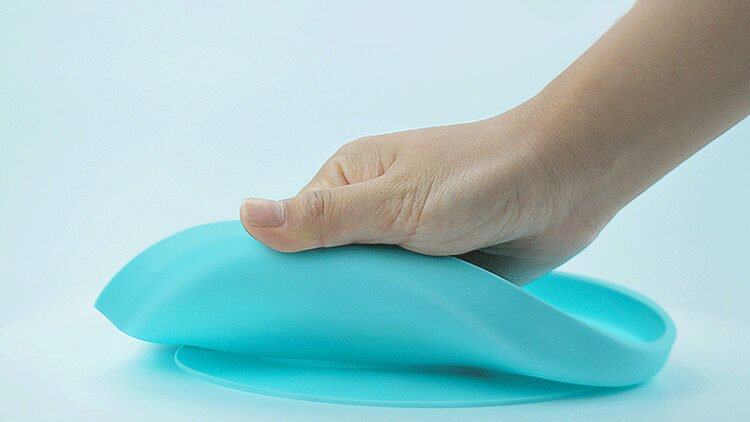
2. Suction Base
A silicone plate with a suction base offers several benefits that can make mealtimes more enjoyable and manageable for both you and your baby:
- Prevents spills and messes: The suction base keeps the plate securely attached to the table or highchair tray, preventing your baby from knocking it over and creating a mess. This can save you time and effort in cleaning up after meals.
- Promotes independence: A stable plate allows your baby to focus on developing their self-feeding skills without the frustration of a constantly moving or tipping plate.
- Reduces distractions: By keeping the plate in place, your baby is more likely to focus on eating instead of playing with their plate.
When choosing a silicone plate with a suction base, consider the following factors:
- Surface compatibility: Ensure that the suction base works well with the surfaces you’ll be using, such as a wooden table or a plastic highchair tray. Some suction bases may not adhere well to certain materials or textured surfaces.
- Strength of suction: Look for a plate with a strong suction base to prevent your baby from easily detaching it. Check product specifications and customer reviews for information on the effectiveness of the suction.
- Ease of removal: While a strong suction is important, it should also be easy for adults to remove the plate when needed. Some plates feature a tab or a quick-release mechanism to facilitate this process.
To ensure that the suction is strong and secure, follow these tips:
- Clean both the suction base and the surface it will be attached to. Dust, crumbs, or other debris can interfere with the suction and compromise its effectiveness.
- Moisten the suction base slightly before attaching it to the surface. This can improve the seal and help the suction cup adhere better.
- Press down firmly on the plate to activate the suction, ensuring that the plate is securely attached to the surface.
- Periodically check the suction during mealtimes to ensure that it remains secure, and reattach it if necessary.
By considering these factors and tips, you can choose a silicone plate with a suction base that effectively stays in place, making mealtimes less messy and more enjoyable for your baby.
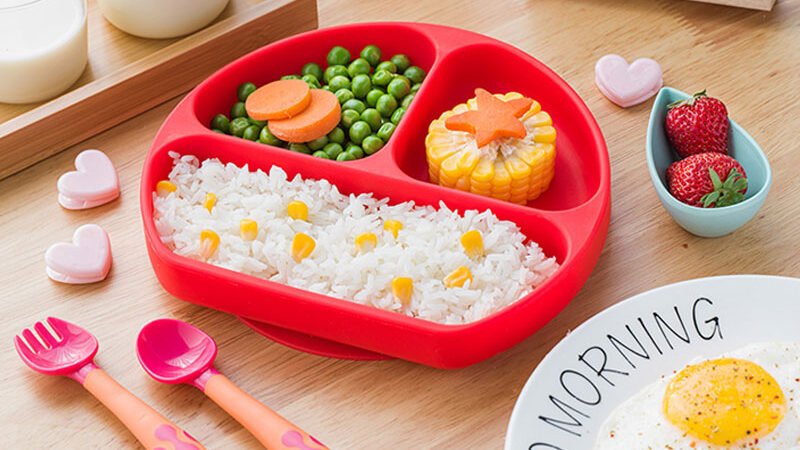
3. Size and Shape
Selecting the appropriate size and shape for your baby’s silicone plate is essential for a comfortable and effective feeding experience. Here are some reasons why it’s important to choose the right size and shape:
- Age-appropriate portions: A suitable plate size helps ensure that your baby receives age-appropriate portion sizes, which can aid in maintaining a healthy diet and preventing overeating.
- Ease of use: The right shape and size make it easier for your baby to scoop up food and develop their self-feeding skills.
- Adaptability: As your baby grows and their eating habits change, the ideal plate size and shape may also change, requiring an adaptable plate design.
When considering the size and shape of a silicone plate, take the following factors into account:
- Age: Younger babies with smaller appetites might require smaller plates, while older babies and toddlers may need larger plates to accommodate their growing appetites.
- Appetite: Consider your baby’s individual appetite when choosing a plate size. Some babies may eat more or less than others of the same age, necessitating a different plate size.
- Feeding stage: As your baby transitions from purees to finger foods, the ideal plate shape may change. For instance, a plate with separate compartments might be more suitable for introducing a variety of foods.
There are various types of silicone plates available, each with its own advantages:
- Divided plates: These plates have separate compartments, making it easy to serve multiple food items without them mixing. This can be particularly helpful for picky eaters who prefer their food separated.
- Plates with raised edges: These plates have elevated sides that make it easier for your baby to scoop up food, promoting self-feeding and reducing spills.
- Shallow plates or bowls: These options provide a versatile solution that can accommodate various types of food, from purees to finger foods.
- Themed or shaped plates: Fun shapes, such as animal designs or geometric patterns, can make mealtimes more enjoyable for your baby and encourage them to eat a variety of foods.
By considering your baby’s age, appetite, and current feeding stage, you can select the ideal size and shape for their silicone plate, ensuring a more enjoyable and effective feeding experience.
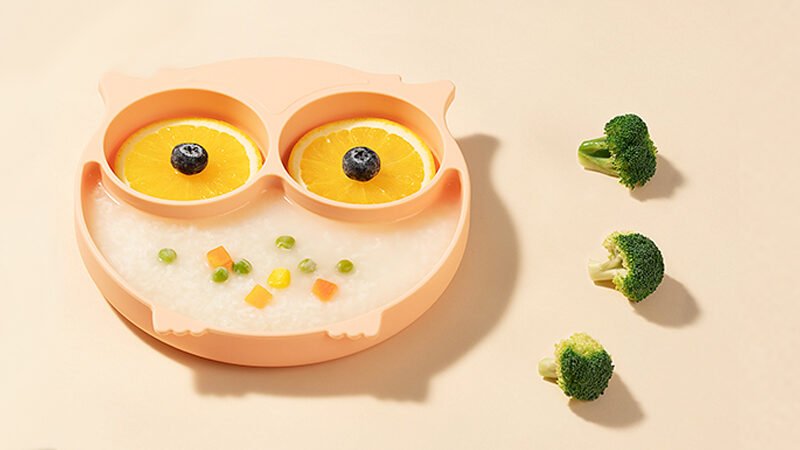
4. Ease of Cleaning
Ensuring that your baby’s silicone plate is easy to clean is essential for maintaining hygiene and saving time during meal preparation and cleanup. The following points highlight the importance of easy-to-clean silicone plates:
- Hygiene: A clean plate helps prevent the growth of bacteria and mold, ensuring a safe and healthy eating environment for your baby.
- Aesthetics: A plate that is easy to clean will maintain its appearance, making it more visually appealing for your baby and encouraging them to eat.
- Efficiency: Spending less time on cleaning means you’ll have more time to spend with your baby or attend to other tasks.
Consider the following cleaning methods and tools when selecting an easy-to-clean silicone plate:
- Dishwasher-safe: Many silicone plates are dishwasher-safe, making cleanup quick and effortless. Check the manufacturer’s recommendations to ensure the plate is suitable for dishwasher use.
- Hand-washing: If you prefer to hand-wash your baby’s plate, look for a design that is easy to clean with a sponge or brush, without any hard-to-reach crevices.
- Microwave-safe: Some silicone plates can be sterilized in the microwave, providing an additional method of cleaning and sanitizing.
To keep your baby’s silicone plate in good condition, follow these tips:
- Rinse the plate immediately after use to prevent food from drying and becoming difficult to remove.
- Use a soft sponge or cloth to clean the plate, avoiding abrasive scouring pads that can damage the silicone surface.
- Regularly inspect the plate for signs of wear or damage, such as cracks or tears, which can harbor bacteria. Replace the plate if necessary.
- Store the plate in a cool, dry place when not in use to prevent the growth of mold or mildew.
By prioritizing ease of cleaning and following these tips, you can maintain a hygienic and efficient feeding environment for your baby, ensuring their health and well-being during mealtimes.
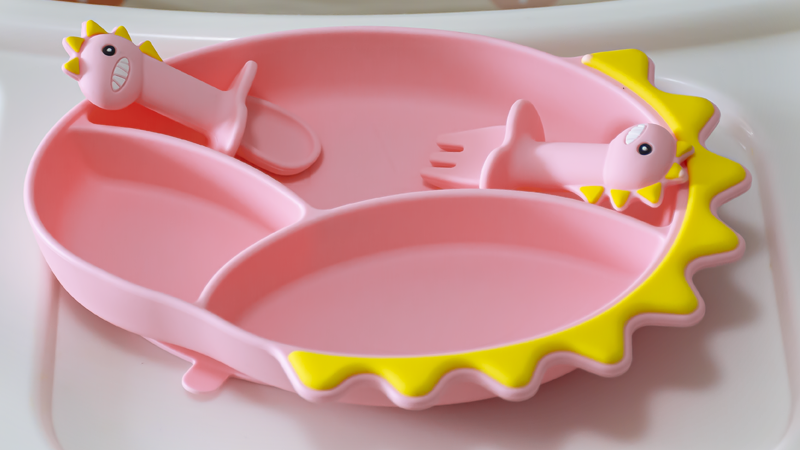
5. Design and Colors
The design and colors of a silicone plate can play a significant role in making mealtimes enjoyable and engaging for your baby. By selecting a plate that your baby will enjoy using, you can encourage their interest in food and foster a positive relationship with eating. Here’s why the design and colors matter:
- Engagement: Fun designs and bright colors can capture your baby’s attention, making them more interested in the food on their plate.
- Stimulation: Attractive designs and colors can stimulate your baby’s senses and promote curiosity about different foods.
- Familiarity: Choosing a plate with a design that features your baby’s favorite characters or themes can create a sense of familiarity and comfort during mealtimes.
When selecting a silicone plate, consider the following factors related to design and colors:
- Color preferences: Consider your baby’s favorite colors or choose colors that complement the décor of your dining area.
- Shape and design: Explore a variety of shapes and designs, such as animals, vehicles, or geometric patterns, to find one that appeals to your baby and matches your personal style.
- Themed plates: If your baby has a favorite character or theme, such as a popular children’s show or movie, consider selecting a plate that incorporates these elements.
There are potential benefits associated with fun designs and colors on a baby’s appetite:
- Increased willingness to try new foods: A visually appealing plate may encourage your baby to sample different foods, expanding their palate and promoting a varied diet.
- Improved mealtime experience: A fun and engaging plate can make mealtimes more enjoyable for your baby, reducing stress and fostering a positive attitude toward eating.
- Enhanced self-feeding skills: A well-designed plate can facilitate self-feeding by making it easier for your baby to scoop up food, promoting independence and skill development.
By considering your baby’s preferences and the potential benefits of engaging designs and colors, you can select a silicone plate that enhances your baby’s mealtime experience and encourages a healthy appetite.
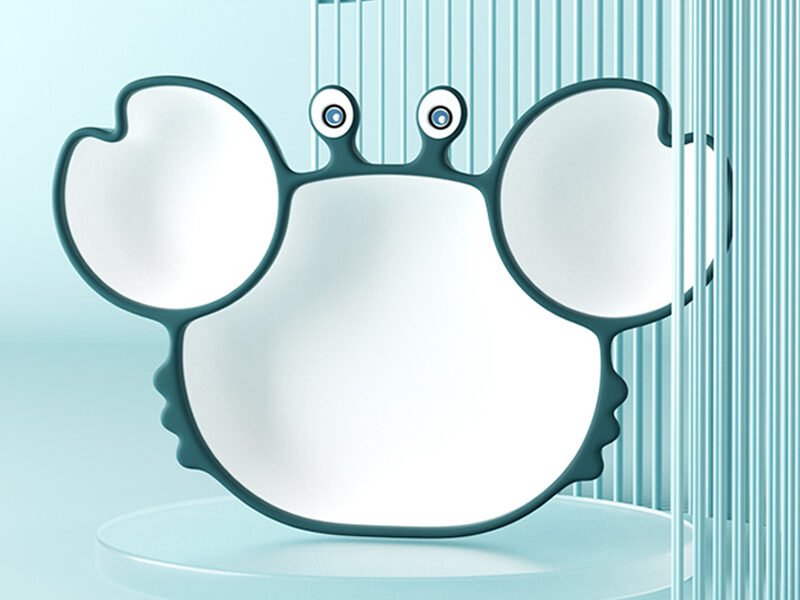
6. Heat Resistance
Heat resistance is an essential factor to consider when selecting a silicone plate for your baby. Ensuring that the plate can withstand heat is crucial for the following reasons:
- Safety: A heat-resistant plate minimizes the risk of melting or deforming when exposed to high temperatures, preventing potential hazards and ensuring the plate remains safe for your baby to use.
- Versatility: A plate that can withstand heat allows you to serve a variety of hot and cold foods, providing flexibility in meal planning and preparation.
- Durability: Heat-resistant silicone plates are less likely to degrade over time due to exposure to high temperatures, ensuring that the plate maintains its shape, functionality, and appearance.
When considering the heat resistance of a silicone plate, keep the following factors in mind:
- Maximum temperature rating: Check the manufacturer’s specifications for the maximum temperature the plate can withstand. Food-grade silicone plates typically have a heat resistance range of -40°F to 450°F (-40°C to 232°C).
- Microwave and oven compatibility: Some silicone plates are microwave- and oven-safe, allowing you to heat food directly on the plate. Verify if the plate you are considering is suitable for these heating methods.
To ensure the safe heating of food in a silicone plate, follow these tips:
- Always adhere to the manufacturer’s guidelines regarding the maximum temperature rating and heating methods. Avoid exposing the plate to temperatures higher than recommended.
- When using a microwave or oven, place the silicone plate on a stable, heat-resistant surface, such as a baking tray or microwave-safe dish, to ensure even heat distribution and prevent spills.
- Use oven mitts or a towel to handle the plate after heating, as the silicone may become hot and cause burns.
- Allow the plate to cool slightly before serving food to your baby to prevent burns or discomfort from hot surfaces.
By considering heat resistance and following these safety tips, you can choose a silicone plate that meets your baby’s feeding needs while ensuring safety and durability during meal preparation and serving.

7. Portability
Portability is an important factor to consider when choosing a silicone plate for your baby, especially if you frequently travel or dine out. A portable plate offers the following advantages:
- Convenience: A portable plate makes it easy to serve your baby meals on the go, ensuring they receive a healthy, home-cooked meal regardless of your location.
- Familiarity: Using the same plate at home and while traveling can provide a sense of familiarity and comfort for your baby, making mealtimes more enjoyable.
- Hygiene: Bringing your own plate can help ensure that your baby’s eating surface is clean and sanitary.
There are different types of silicone plates that are designed for easy transport:
- Collapsible plates: These plates can be folded or compressed into a compact size, making them easy to fit into a diaper bag or purse.
- Roll-up plates: Some silicone plates can be rolled up, taking up minimal space in your bag while still providing a durable and easy-to-clean eating surface.
- Plate and placemat combos: These options combine a plate with a placemat, providing an all-in-one solution that is easy to pack and transport.
To ensure that your baby’s silicone plate stays clean and safe during travel, follow these tips:
- Pack the plate in a clean, airtight container or a resealable plastic bag to protect it from dirt and contamination.
- Bring along a small bottle of dish soap and a sponge or cloth to clean the plate after use, or use baby-safe sanitizing wipes if washing facilities are unavailable.
- Allow the plate to air-dry completely before packing it away to prevent the growth of mold or mildew.
- Regularly inspect the plate for signs of wear or damage, especially after traveling, and replace it if necessary to maintain hygiene and safety.
By selecting a portable silicone plate and following these travel tips, you can ensure that your baby has a clean and familiar eating surface wherever you go, making mealtimes more enjoyable and stress-free.
8. Price and Value
When selecting a silicone plate for your baby, it’s essential to balance price with quality and features. While it’s tempting to choose the most affordable option, it’s crucial to consider the following points:
- Quality: A higher-priced plate may offer better quality, ensuring that it lasts longer, remains safe for your baby to use, and provides a more enjoyable eating experience.
- Features: More expensive plates may include additional features, such as a suction base or divided compartments, that can enhance your baby’s mealtime experience and make feeding more convenient.
- Long-term value: Investing in a high-quality silicone plate can result in long-term savings, as the plate is less likely to wear out or require replacement.
Here are some tips for finding a good-value silicone plate:
- Research brands and reviews: Look for reputable brands and read customer reviews to get an idea of the quality, durability, and functionality of different silicone plates.
- Compare prices: Shop around and compare prices from different retailers to ensure you’re getting the best value for your money.
- Consider your baby’s needs: Assess your baby’s current feeding stage and preferences to determine which features are essential and which may not be necessary, allowing you to invest in a plate that meets your needs without overspending.
- Look for sales or discounts: Keep an eye out for sales or special promotions that can help you save money on a high-quality silicone plate.
Investing in a high-quality silicone plate can lead to potential long-term savings, such as:
- Durability: A well-made plate will last longer, reducing the need for frequent replacements.
- Safety: A high-quality plate is less likely to contain harmful chemicals or degrade over time, ensuring that your baby’s eating surface remains safe.
- Convenience: A plate with useful features, such as a strong suction base or easy-to-clean design, can save you time and effort during mealtimes.
By balancing price with quality and features and following these tips, you can find a silicone plate that offers excellent value for your money, providing a safe, durable, and enjoyable eating experience for your baby.
Conclusion
In conclusion, when selecting a silicone plate for your baby, consider factors such as high-quality food-grade silicone material, a strong suction base, the appropriate size and shape, ease of cleaning, engaging designs and colors, heat resistance, portability, and a balance between price and features. By prioritizing safety, quality, and practicality, you can provide a convenient, durable, and enjoyable eating experience for your baby.